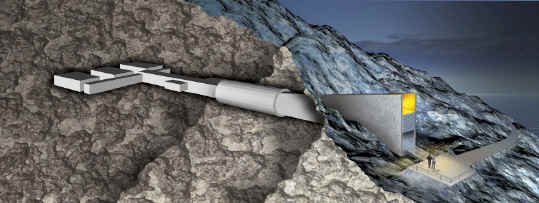 |
Its not
science-fiction, and this is not a scene
from some movie, The
Doomsday vault or better known as the Svalbard Global Seed Vault
(Norwegian: Svalbard globale frøhvelv)
is a secure seed bank on the Norwegian island of Spitsbergen near Longyearbyen in the remote Arctic Svalbard archipelago, about 1,300 kilometres (810 mi) from the North Pole.
The seedbank is 120 metres (390 ft) inside a sandstone mountain,
and employs robust security systems. Seeds are packaged in special four-ply packets and heat sealed to exclude moisture. The facility is managed by the Nordic Genetic Resource Center, though there are no permanent staff on-site.
Spitsbergen was considered ideal because it lacked tectonic activity and had permafrost, which aids preservation. Its being 130 metres (430 ft) above sea level will keep the site dry even if the ice caps
melt.

|
 |
|
A feasibility study prior to construction determined that the vault could, for hundreds of years, preserve most major food crops' seeds. Some, including those of important grains, could survive far longer—possibly thousands of
years.
The Svalbard Global Seed Vault officially opened on 26 February
2008. Approximately 1.5 million distinct seed samples of agricultural crops are thought to exist. The variety and volume of seeds stored will depend on the number of countries participating – the facility has a capacity to conserve 4.5 million. The first seeds arrived in January
2008. Five percent of the seeds in the vault, about 18,000 samples with 500 seeds each, come from the Centre for Genetic Resources of the Netherlands (CGN), part of Wageningen University,
Netherlands. By 2013, approximately one-third of the genera diversity stored in gene banks globally was represented at the Seed Vault.
|

